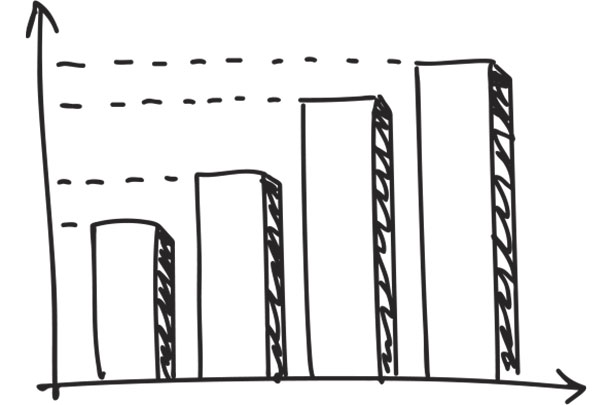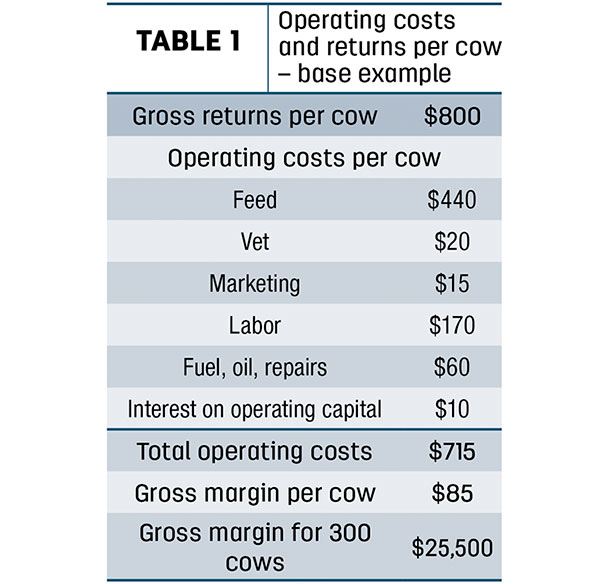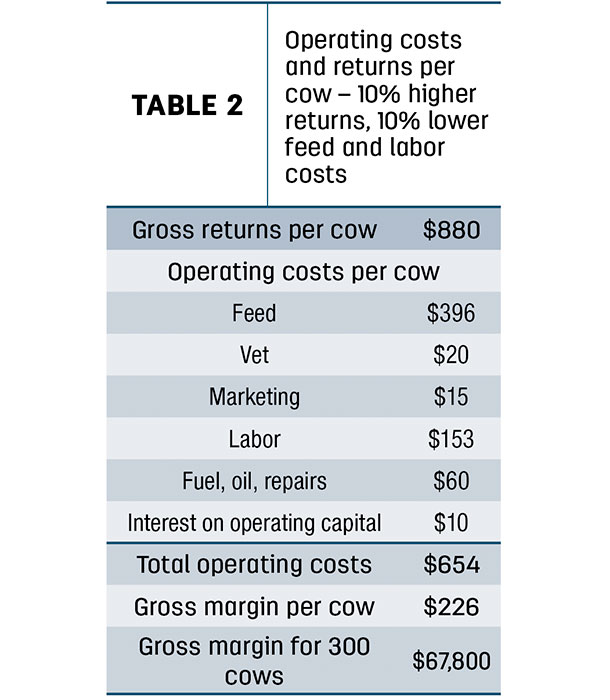Some efficiency can be gained through expansion, but expansion can be difficult and risky, and there may be a better way to improve profitability.
Gross margin is the key. If we have a solid, positive gross margin, we may be ready for expansion. The more cows we run, the more profitable our business will be. However, if our gross margin is low and we’re not able to cover our overhead costs, expansion will kill our business. The more cows we run, the more money we will lose. Managing to improve gross margin can be more profitable than expansion.
What is gross margin?
Gross margin measures how efficiently resources are used to generate profit. Gross margin is also referred to as net returns above production costs, or the difference between total revenue and production costs.
Gross margin = total revenue - production costs
Gross margin is calculated in two steps: First, estimate the gross revenue including sales of steer calves, heifer calves, cull cows, cull bulls and cull replacement heifers. Second, calculate production costs including feed, veterinary, marketing, labor, fuel, repairs, interest and others. Gross margin can be measured on a per-head or per-cow basis. Breaking down revenue and costs on a per-cow basis helps put things in perspective and makes the numbers more manageable.
 Gross margin is the operating profit used to cover overhead/ownership costs. The higher our gross margin, the more money available to cover expenses such as depreciation, land and interest on retained livestock.
Gross margin is the operating profit used to cover overhead/ownership costs. The higher our gross margin, the more money available to cover expenses such as depreciation, land and interest on retained livestock.
A good gross margin will cover overhead expenses and still provide some profit for re-investment, capital improvements or even a trip to Hawaii. (A little side note on overhead costs: Sometimes overhead costs are referred to as “fixed” ownership costs. This implies they are fixed and cannot change, which is not true. Overhead costs might take more effort and time to change, but we can and should continually work to lower them. Reducing overhead costs is one of the main ways to improve profitability, but that’s a discussion for another article.)
Improving gross margin
There’s no silver bullet to improving gross margin. The two strategies are simple – but aren’t easy. Either increase revenue or decrease production costs, or a combination of the two.
Increasing revenue is all about improving marketing skills. Marketing is often the weakest link in the management system and the greatest opportunity for increasing profitability. Most ranchers who are still in business today are good producers – we have production figured out. Because of increased price volatility, marketing is a major challenge for today’s producers.
We may need to completely re-think our marketing program. There are many ways to increase revenue. Weaning more calves, backgrounding and preconditioning, improving uniformity, adjusting lot sizes, reducing stress and shrink, direct marketing, putting weight on cull cows, hedging, livestock risk protection insurance (LRP), taking advantage of seasonal and long-term price cycles, and improving timing are a few options to consider.
If you follow the futures market, you understand the importance of timing. Here’s an example from feeder cattle futures this year (as of Oct. 15).The 12-month high was $162, and the low was $127. That’s a $35-per-hundredweight (cwt) price difference, a 21% change. If we improve our market timing and gain $10 (less than a third of the price change), that would add $50 to the selling price of each calf; that’s $50 directly added to our gross margin per cow. There’s so much volatility in the markets, spending a few minutes each day watching trends and price signals can really pay off.
Decreasing production costs per cow may seem like a tough task. We may think our costs are as low as they can go – we have nothing else to cut without decreasing productivity. This is the tight-rope smart managers walk, the balance between decreasing costs and increasing productivity. The point where we maximize profit is not the same point as where we maximize production. A producer who gets 100% of his cows rebred in a 60-day window will have a much higher cost per cow than his neighbor who is content (and more profitable) with a 92% conception rate. We could all wean 800-pound calves, but at what cost? We’re in business to make a profit, not to brag about calving rates and weaning weights at the local coffee shop.
Start with the big-cost categories when trimming per-cow costs. A 1% decrease in a big number may be better than a 10% decrease in a small number. Feed and labor are often the big production costs on a cow-calf operation. A 10% decrease in those costs alone will have a huge impact on our gross margin – maybe even double it.
There are always ways to improve efficiency and lower expenses for feed, fuel, repairs, vet, marketing, labor and operating interest. This is one time being a micro-manager will pay off. Cutting production costs may require a completely new management system. Think outside the box – drive a car instead of a pickup, buy fuel in January, calve in synch with nature, rent more pasture and feed less hay, re-examine vet/health programs, and the list goes on. Of course, it helps to know and track actual costs before we start planning.
An example
The tables illustrate how increasing revenue and decreasing production costs can change the gross margin for a 300-cow ranch.
Table 1 represents the costs and returns for a typical cow-calf operation with gross returns of $800 and total operating expenses of $715 per cow. 
The gross margin is $85 per cow or $25,500 for the 300-cow ranch. This means there is only $25,500 left to cover all the overhead costs. That’s probably not enough.
Table 2 represents the costs and returns for the same ranch with a simple but realistic 10% increase in returns and 10% decrease in feed and labor costs.
 Gross returns increased to $880, and total operating expenses decreased to $654 per cow. The gross margin is now $226 per cow or $67,800 for the 300-cow ranch. The result is a 265% increase in gross margin. The ranch now has $67,800 to contribute to overhead costs. Business expansion may be on the horizon.
Gross returns increased to $880, and total operating expenses decreased to $654 per cow. The gross margin is now $226 per cow or $67,800 for the 300-cow ranch. The result is a 265% increase in gross margin. The ranch now has $67,800 to contribute to overhead costs. Business expansion may be on the horizon.
Gross margin may be the most important number for any business manager to know. Improving gross margin is the first way to increase profitability, and a healthy gross margin is a prerequisite for successful business expansion.
The University of Idaho has many livestock and crop cost and returns estimates that can help you calculate your own gross margin. They can also be used as benchmarks to compare your operation with. To access budgets, go to the Idaho AgBiz website. They can be downloaded in a customizable Excel spreadsheet and PDF format. ![]()
Getty Images.

-
Ben Eborn
- Extension Ag Economist
- University of Idaho
- Email Ben Eborn









